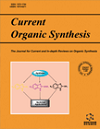- Home
- A-Z Publications
- Current Organic Synthesis
- Previous Issues
- Volume 8, Issue 4, 2011
Current Organic Synthesis - Volume 8, Issue 4, 2011
Volume 8, Issue 4, 2011
-
-
Editorial [Hot Topic: Organic Chemistry Meets with Molecular Imaging (Guest Editor: Zhen Cheng)]
More LessBy Zhen ChengMedical imaging has been used for disease diagnosis as well as physiological assessment for over one hundred years since the discovery of X-rays by Professor Roentgen. Thanks to the ever evolving fields of physics and medicine, the past century has witnessed the rapid development and advancement of many powerful imaging modalities such as X-ray, nuclear imaging, ultrasound, computed tomography (CT) and magnet Read More
-
-
-
Molecular Imaging Probe Development Using Microfluidics
More LessAuthors: Kan Liu, Ming-Wei Wang, Wei-Yu Lin, Duy Linh Phung, Mark D. Girgis, Anna M. Wu, James S. Tomlinson and Clifton K.-F. ShenIn this manuscript, we review the latest advancement of microfluidics in molecular imaging probe development. Due to increasing needs for medical imaging, high demand for many types of molecular imaging probes will have to be met by exploiting novel chemistry/radiochemistry and engineering technologies to improve the production and development of suitable probes. The microfluidicbased probe synthesis is curre Read More
-
-
-
Molecular Probes for Bioluminescence Imaging
More LessAuthors: Song Wu, Edwin Chang and Zhen ChengBioluminescence refers to the emission of light from a living system in which photoproteins such as luciferase enzymes oxidize their substrates to produce light. Because of its high-sensitivity and low-toxicity, bioluminescence imaging (BLI) is particularly useful for in vitro assays and in vivo small animal imaging. It provides a powerful tool to study various important biological questions and processes including gene and protein exp Read More
-
-
-
Activatable Optical Probes for the Detection of Enzymes
More LessAuthors: Christopher R. Drake, David C. Miller and Ella F. JonesThe early detection of many human diseases is crucial if they are to be treated successfully. Therefore, the development of imaging techniques that can facilitate early detection of disease is of high importance. Changes in the levels of enzyme expression are known to occur in many diseases, making their accurate detection at low concentrations an area of considerable active research. Activatable fluorescent probes Read More
-
-
-
Near-Infrared Dyes: Probe Development and Applications in Optical Mole-cular Imaging
More LessAuthors: Donald D. Nolting, John C. Gore and Wellington PhamThe recent emergence of optical imaging has brought forth a unique challenge for chemists: development of new biocompatible dyes that fluoresce in the near-infrared (NIR) region for optimal use in biomedical applications. This review describes the synthesis of NIR dyes and the design of probes capable of noninvasively imaging molecular events in small animal models.
-
-
-
Strategies for the Preparation of Bifunctional Gadolinium(III) Chelators
More LessAuthors: Luca Frullano and Peter CaravanThe development of gadolinium chelators that can be easily and readily linked to various substrates is of primary importance for the development high relaxation efficiency and/or targeted magnetic resonance imaging (MRI) contrast agents. Over the last 25 years a large number of bifunctional chelators have been prepared. For the most part, these compounds are based on ligands that are already used in clinically approved co Read More
-
-
-
Recent Advances in the Probe Development of Technetium-99m Molecular Imaging Agents
More LessAuthors: Paul D. Benny and Adam L. MooreThe development of technetium based diagnostic imaging agents continues to remain a high impact area in nuclear medicine research. In particular, the single photon emitting radionuclide 99mTc comprises the majority of diagnostic imaging scans performed daily at hospitals and clinics. While research with 99mTc has been active for several decades, this review focuses on the overview of recent developments and Read More
-
-
-
Recent Progress in Radiofluorination of Peptides for PET Molecular Imaging
More LessAuthors: Shuanglong Liu, Bin Shen, Frederick T. Chin and Zhen ChengBecause of its low positron energy, lack of side emission, and a moderate half-life, Fluorine-18 (β+, 0.635 MeV [97%], t1/2 = 109.8 min) has ideal physical properties for positron emission tomography (PET). With the increasing numbers of peptides that are potentially applicable for molecular imaging of diseases, novel and simple 18F-labeling methods have been actively investigated and reported. In this review, a few well esta Read More
-
-
-
Molecular Imaging of Hypoxia: Strategies for Probe Design and Application
More LessAuthors: Sandeep Apte, Frederick T. Chin and Edward E. GravesTumor hypoxia is a negative prognostic factor and its precise imaging is of great relevance to therapy planning. The present review summarizes various strategies of probe design for imaging hypoxia with a variety of techniques such as PET, SPECT and fluorescence imaging. Synthesis of some important probes that are used for preclinical and clinical imaging and their mechanism of binding in hypoxia are also discussed.
-
-
-
Radiolabeled Oligonucleotides for Antisense Imaging
More LessAuthors: Arun K. Iyer and Jiang HeOligonucleotides radiolabeled with isotopes emitting γ-rays (for SPECT imaging) or positrons (for PET imaging) can be useful for targeting messenger RNA (mRNA) thereby serving as non-invasive imaging tools for detection of gene expression in vivo (antisense imaging). Radiolabeled oligonucleotides may also be used for monitoring their in vivo fate, thereby helping us better understand the challenges to its delivery fo Read More
-
Volumes & issues
-
Volume 22 (2025)
-
Volume 21 (2024)
-
Volume 20 (2023)
-
Volume 19 (2022)
-
Volume 18 (2021)
-
Volume 17 (2020)
-
Volume 16 (2019)
-
Volume 15 (2018)
-
Volume 14 (2017)
-
Volume 13 (2016)
-
Volume 12 (2015)
-
Volume 11 (2014)
-
Volume 10 (2013)
-
Volume 9 (2012)
-
Volume 8 (2011)
-
Volume 7 (2010)
-
Volume 6 (2009)
-
Volume 5 (2008)
-
Volume 4 (2007)
-
Volume 3 (2006)
-
Volume 2 (2005)
-
Volume 1 (2004)
Most Read This Month
Article
content/journals/cos
Journal
10
5
false
en


